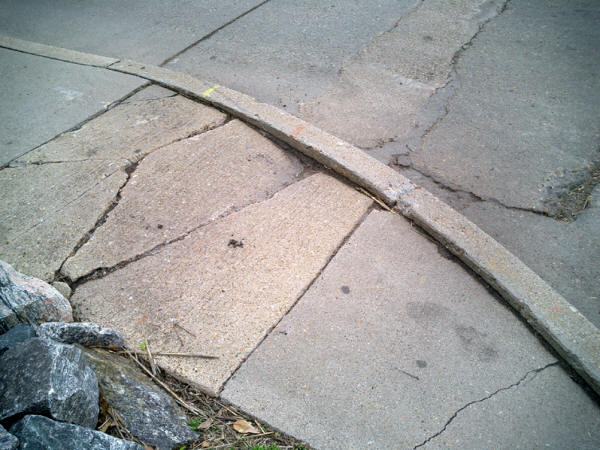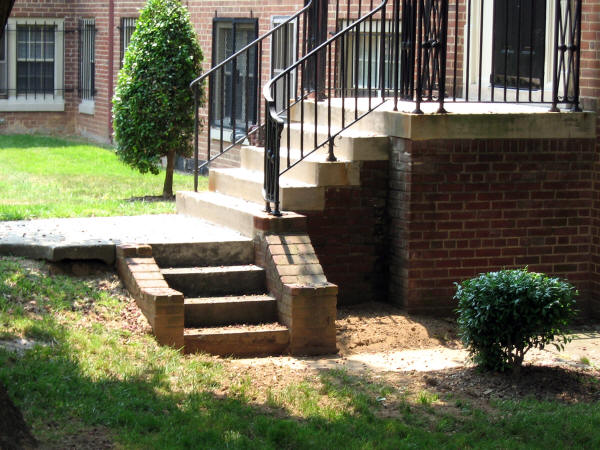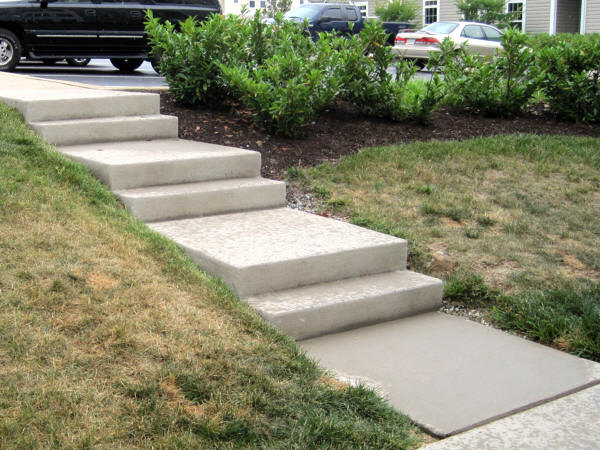Inspectable Item: Walkways and Steps
Notes

You will be cited for Trip Hazards, but that's not a sidewalk defect, per se.
If streets and/or sidewalks belong to the city, county, or other governmental agency, the should not be inspected at all.

None of these ever had handrails in the 50 year history of the property - but they were cited during the REAC inspection.
They were cited 50 times - yes - but it only counted once as a Site defect. It resulted in about a 5 or 6 point deduction, just as if it had only been cited once.
We would suggest appealing something like this as a pre-existing condition pre-dating the UPCS - which is much like being "grandfathered."
Instead, the property installed over 100 sections of wrought iron handrails to match the existing ones.

The best approach to sidewalks and steps is to simply insist on eliminating all Trip Hazards and making sure there are no bad or missing handrails.
The rest is long term capital planning. You don't (reasonably) tear out and redo your sidewalks just because you have a REAC inspection coming up.
| Walkways/Steps (Site) |
| Passages for walking and the structures that allow for changes in vertical orientation. |
| This inspectable item can have the following deficiencies: |
| Broken/Missing Hand Railing |
| Cracks/Settlement/Heaving |
| Spalling |
| Broken/Missing Hand Railing (Walkways/Steps—Site) |
| Deficiency: The handrail is damaged or missing. |
| Level of Deficiency: |
| - Level 1: N/A |
| - Level 2: N/A |
| - Level 3: The handrail for 4 or more stairs is missing, damaged, loose, or otherwise unusable. |
| Cracks/Settlement/Heaving (Walkways/Steps—Site) |
| Deficiency: |
| —Visible faults in the pavement: longitudinal, lateral, alligator, etc. |
| -OR- |
| —Pavement that sinks or rises because of the failure of sub-base materials. |
| Note: |
| 1. Do not include cracks on parking lots/driveways or roads. |
| 2. For this to be a Level 2 deficiency, 5% of the walkways must be impacted, for example, 50 out of 1,000 square feet. |
| 3. Relief joints are there by design; do not consider them cracks. |
| 4. Repaired/sealed cracks should not be considered a deficiency. |
| Level of Deficiency: |
| - Level 1: N/A |
| - Level 2: Damaged, as defined above, is greater than3/4inch, hinging/tilting, or missing section(s) that affect more than 5% of the property's walkways/steps. |
| - Level 3: N/A |
| Comment: |
| - Level 2: If the walkways or steps could cause tripping or falling, you must manually record this deficiency under “Hazards (Health and Safety).” |
| Spalling (Walkways/Steps—Site) |
| Deficiency: A concrete or masonry walkway is flaking, chipping, or crumbling, possibly exposing underlying reinforcing material. This is a defect if 5% or more of the property's walkways/steps are affected. For example, 50 square feet out of 1,000 square feet. |
| Note: When observing traffic ability, consider the capacity to support people on foot, in wheelchairs, and using walkers. |
| Level of Deficiency: |
| - Level 1: More than 5% of the walkway/steps have small areas of spalling, 4 inches by 4 inches or less. |
| - Level 2: More than 5% of the walkway/steps have large areas of spalling, larger than 4 inches by 4 inches, and this affects traffic ability. |
| - Level 3: N/A |
SITE
A. Site General Information
1. When recording a location for a Site deficiency in the 4.0 software associate it with the nearest building.
2. The inspector is required to input in the UPCS software the total square footage for Parking
Lots/Driveways/Roads and Walkways/Steps. The inspector is to request the square footage information from the property representative. If it is unavailable, the inspector will have to use their judgment to make a professional estimate.
3. To determine a deficiency for inspectable items, which use proportionality, evaluate the defect area as a percentage of the total applicable area of all individual sites.
4. Parking Lots/Driveways/Roads and Walkways/Steps proportionality deficiencies must continue to be recorded after the minimum deficiency threshold is reached (10% for Parking Lots/Driveways/Roads and 5% for Walkways/Steps).
5. All roadways and walkways that the property represents as being owned by the property need to be inspected. Roadways and walkways that the property represents as owned by a public authority such as the city, county, or state are not to be inspected.
p 31
P. Patio/Porch/Balcony
1. Damage to a concrete slab porch or entry stoop must be recorded in [Site], [Walkways/Steps]… as applicable.
p 35
M. Patio/Porch/Balcony
1. Damage to a concrete slab porch or entry stoop must be recorded in Site, Walkways/Steps, as applicable.
2. Record damage to balusters and side rails in Baluster/Side Railings. All other deficiencies observed on unit patios, porches, and balconies must be recorded in the associated unit in their respective area.